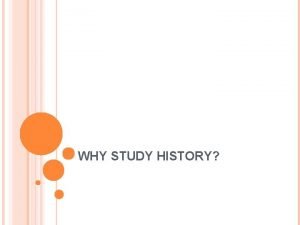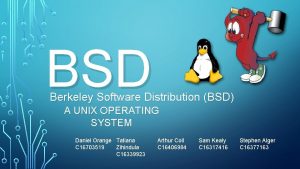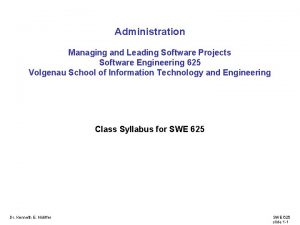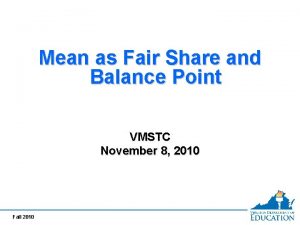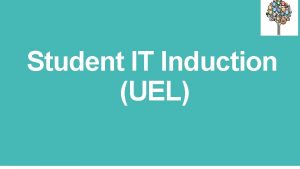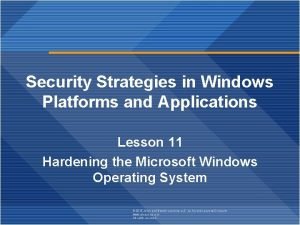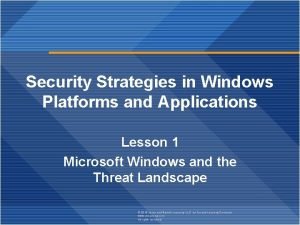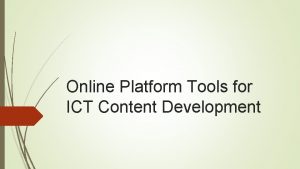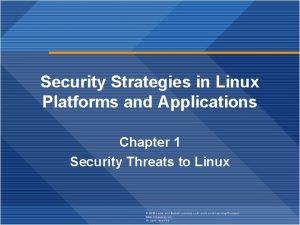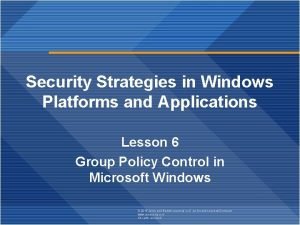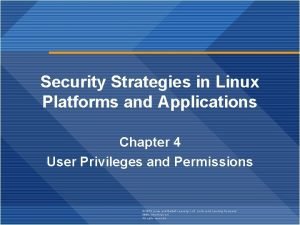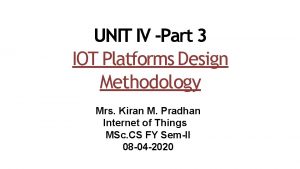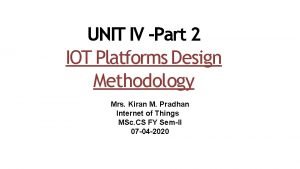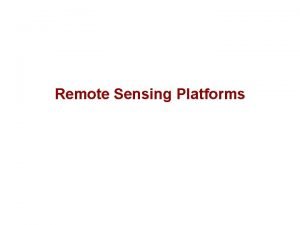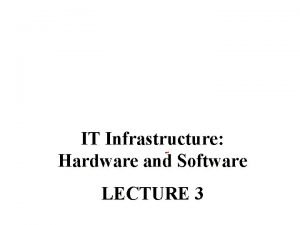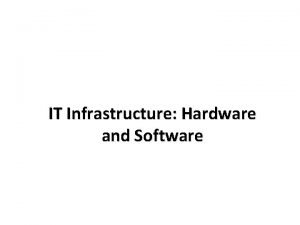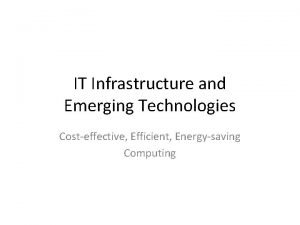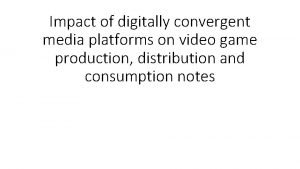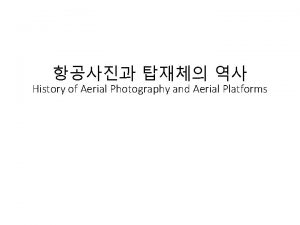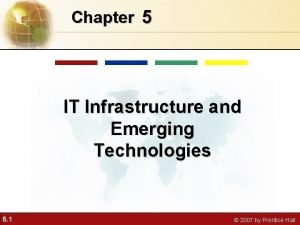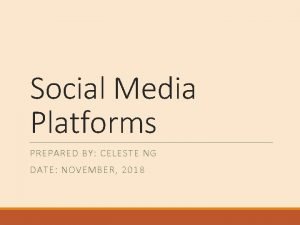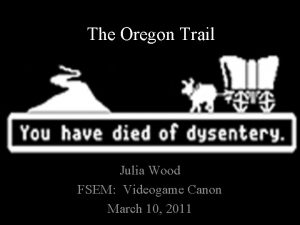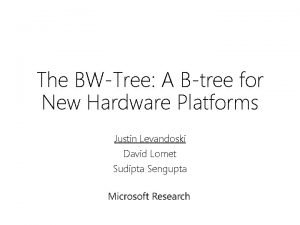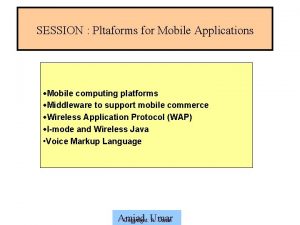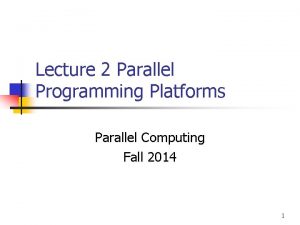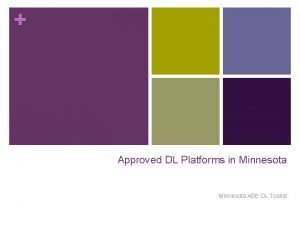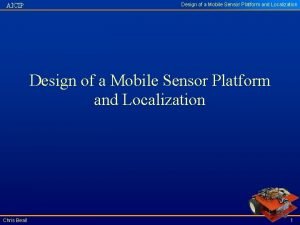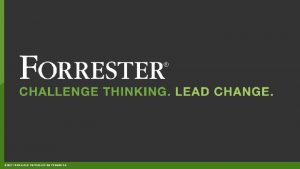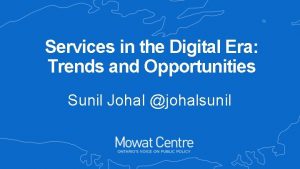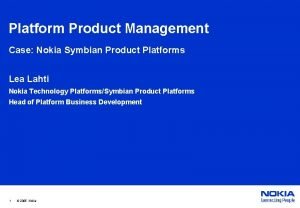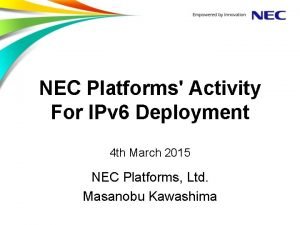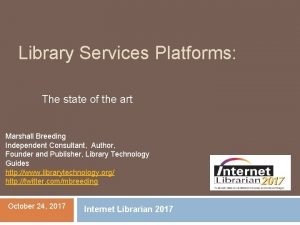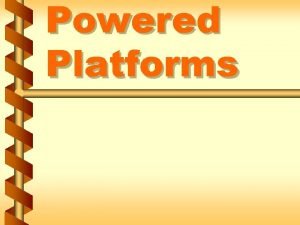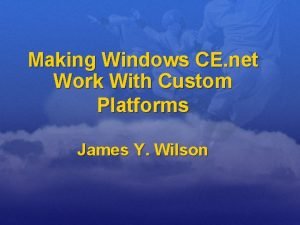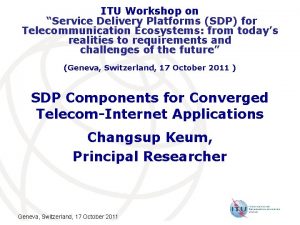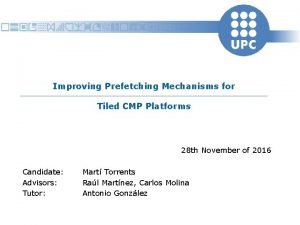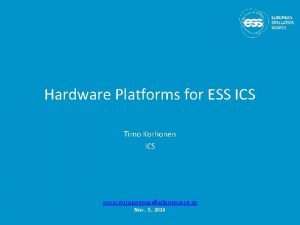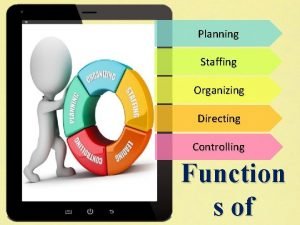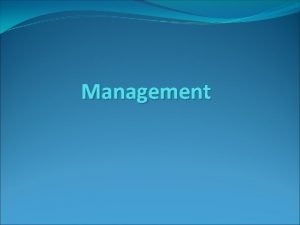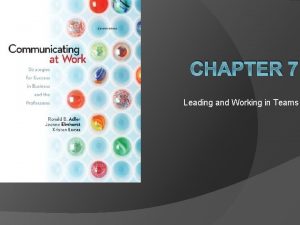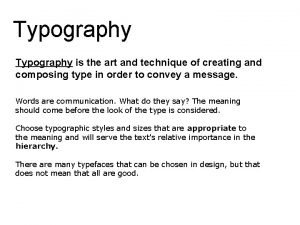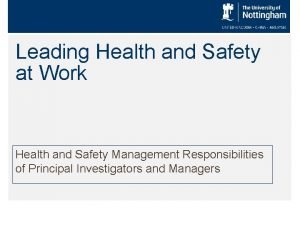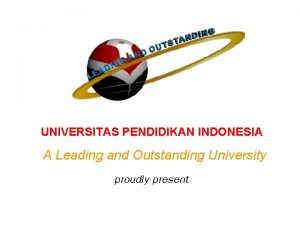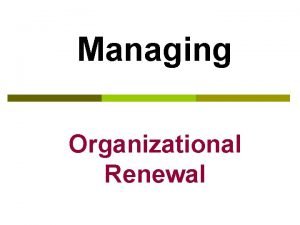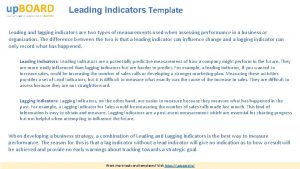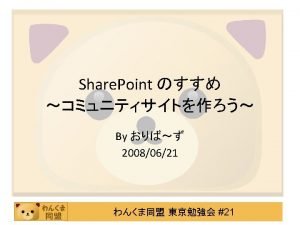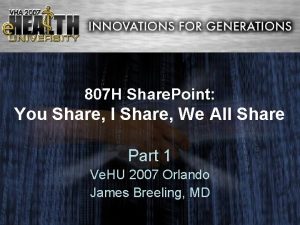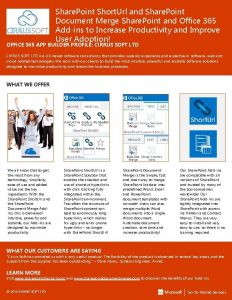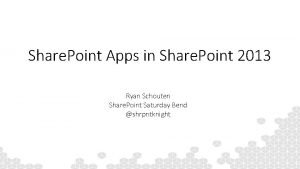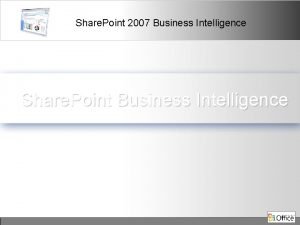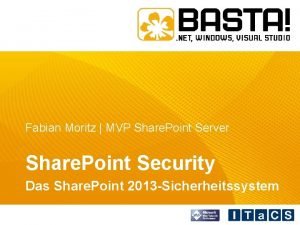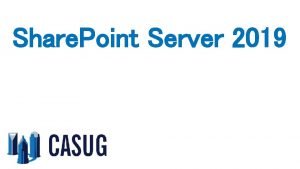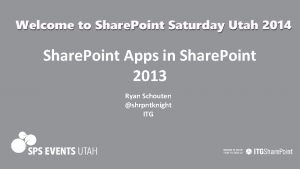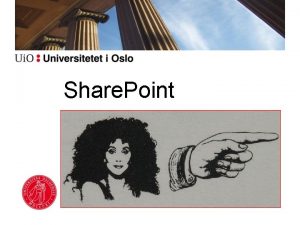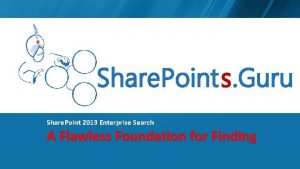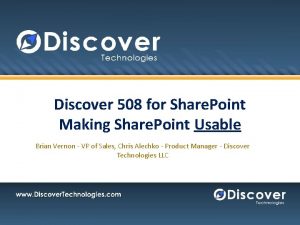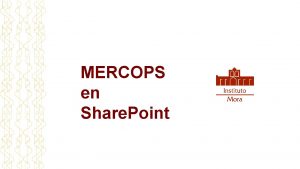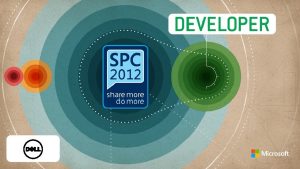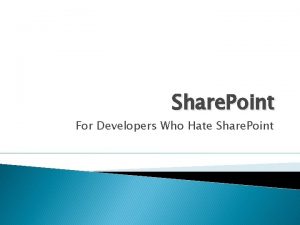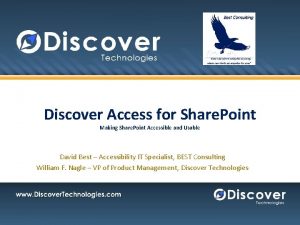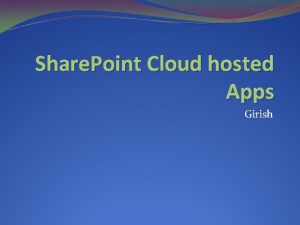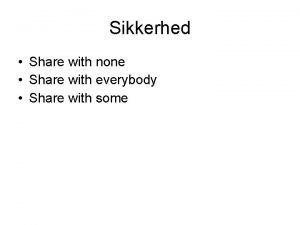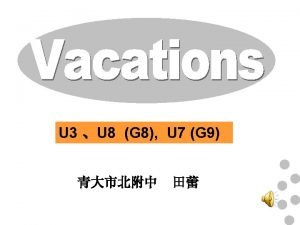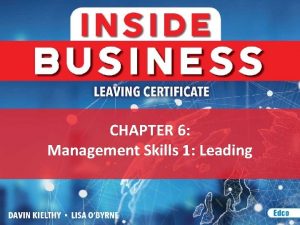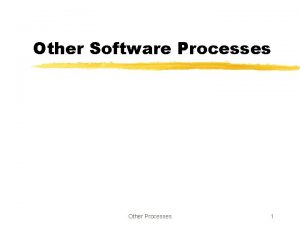Understand Share Point and Other Leading Software Platforms



























































- Slides: 59

Understand Share. Point and Other Leading Software Platforms to Optimize Internal KM Systems Eleonora Babayants Galaxy Consulting

Agenda 1. Share. Point Content types Ø Workflows Ø Taxonomy Ø Search Ø Collaboration Ø Business Solutions 2. Other Content Management Systems Ø Documentum Ø Team. Site Ø Open Text ECM Suite Ø Oracle UCM Ø Information Request Management System (IRMS) Ø Open source CMS 3. Information governance 4. User adoption strategies 5. Q & A Ø

Content Types Ø A content type is a group of settings that describe the shared behavior of a specific group of documents. Ø Content types make it possible to organize and manage documents in a consistent way across a site. Ø Categorize your documents: Document Type = Content Type For example, SOPs, Work Instructions, White Papers, Articles. Ø In GMP environment, there are controlled documents. Content types are very useful to manage them. Galaxy Consulting www. galaxyconsulting. net

Content Types Hierarchy Ø Content types are organized into a hierarchy: parent and child content types. Ø Site content types ---> parent content types. Ø Library or list content types ---> child content types. Ø Site content type ---> metadata, workflows, policies. Ø Library content type ---> will inherit them. Ø Create libraries ---> select a site content type --> all metadata, workflows, policies will be applied. Ø Change settings for many libraries ---> change the site content type. Galaxy Consulting www. galaxyconsulting. net Ø Change settings for one library only ---> change that library settings only; it will not override the parent type.

Galaxy Consulting www. galaxyconsulting. net

Galaxy Consulting www. galaxyconsulting. net


Galaxy Consulting www. galaxyconsulting. net

Galaxy Consulting www. galaxyconsulting. net

Galaxy Consulting www. galaxyconsulting. net

Workflows Ø Workflow is the automated movement of documents through a sequence of actions or tasks. Ø Workflows can streamline the cost and time required to coordinate business processes. Ø Set up workflows before they can be started – either in a content type or a library level. Ø Start a workflow at an item level. Ø Workflow status can be checked by users. Ø Workflow can be customized by users. Ø Workflows can be modified when in progress. Ø Types – approval, collect feedback, collect signatures, three-state. Galaxy Consulting www. galaxyconsulting. net

Workflow Types Ø Approval – routes a document to people for approval. Example: controlled documents. Ø Collect Feedback – routes a document to people for feedback. Ø Collect Signatures – routes a document to people to collect their digital signatures. Ø Three-State – manages expiration and management of obsolete documents. This is especially important in the case of controlled documents. Galaxy Consulting www. galaxyconsulting. net

Galaxy Consulting www. galaxyconsulting. net

Galaxy Consulting www. galaxyconsulting. net


Galaxy Consulting www. galaxyconsulting. net

Galaxy Consulting www. galaxyconsulting. net


Taxonomy Ø Taxonomy is a hierarchical structure for the classification and organization of content. Ø Taxonomy is very important for Share. Point navigation and browsing. Ø Taxonomy development requires cooperation of departments. Ø Successful taxonomy – not too deep and not too wide. Ø There is no such thing as finished taxonomy. Ø Taxonomy in Share. Point is represented by sites, sub-sites, libraries, lists, and folders. Ø Create taxonomy before you start creating sites, sub-sites, libraries, lists, folders. Ø 2010 version offers taxonomy management – taxonomy store – managed metadata service. Galaxy Consulting www. galaxyconsulting. net

Taxonomy Factors Ø There are three key factors in taxonomy development: business context, content, and a user. Ø Business Context - What is the purpose of the taxonomy? How is the taxonomy going to be used? Ø Content - What is the content scope? Possibilities include companywide, within an organizational unit, etc. Ø What content sources will the taxonomy be built upon? Ø User - Who will be using the taxonomy? Possibilities include employees, customers, partners, etc. What are the user profiles? Ø Construct taxonomy with users feedback. Galaxy Consulting www. galaxyconsulting. net

Galaxy Consulting www. galaxyconsulting. net

Search Ø Full text search – quick search. Ø Full text search – advanced search. Ø Create a site “advanced search”, edit the web part to update metadata. Ø The crawler and metadata have to be configured on the server administration level. Ø Limit search results by site. Ø Limit search results - metadata search. Galaxy Consulting www. galaxyconsulting. net

Search 2010 Ø Search significantly improved in 2010 version. Ø People and experience search: v dedicated ranking system based on My Site; v phonetic and nickname search – Geoff and Jeff; v keyword and colleague mining – extracts information from messages in Outlook. Galaxy Consulting www. galaxyconsulting. net Ø Content search: v metadata refinement – faceted search; v click through relevancy – based on users clicking for similar queries; v taxonomy tag integration; v advanced content processing – extract and create metadata to improve search results; v contextual search – refinement based on the user profile; v thumbnails and previews.

Galaxy Consulting www. galaxyconsulting. net




Collaboration Ø Wiki – quickly capture and share ideas by creating simple pages with links that anybody can edit. Great tool for brainstorming! Ø Blog – web site that enables to share the information. Contains dated posts in chronological order and comments. Ø Discussion Boards – to share information and discuss topics with other people. Ø My Site – is a personal site that gives you a central location to manage and store your documents, content, links, and contacts. Galaxy Consulting www. galaxyconsulting. net





Galaxy Consulting www. galaxyconsulting. net

Business Solutions Ø Electronic Forms – can create forms using Info. Path. Ø Project Management – the site that allows to track project tasks. Ø Issues Tracking – list to track issues. Ø Surveys – can create and send surveys. Ø Dashboards – to display business data and reports. Galaxy Consulting www. galaxyconsulting. net

Galaxy Consulting www. galaxyconsulting. net


Galaxy Consulting www. galaxyconsulting. net

Galaxy Consulting www. galaxyconsulting. net

Galaxy Consulting www. galaxyconsulting. net

Galaxy Consulting www. galaxyconsulting. net

Galaxy Consulting www. galaxyconsulting. net




Other CMS Documentum Ø Produced by EMC and includes: v Content Security - secure access to sensitive information: � Documentum Information Rights Management � Documentum IRM Client for E-Mail � Documentum IRM Client for Microsoft Office � Documentum IRM Client for PDF � Documentum Trusted Content Services v Digital Asset Management - for managing digital assets; v Records Management - to control records lifecycle: � Documentum Federated Records Services � Documentum Physical Records Services � Documentum Records Manager � Documentum Retention Policy Services

Other CMS Documentum v Documentum Standard - to organize and control enterprise content; � Documentum Center. Stage � Documentum e. Room - online team collaboration � Documentum Platform – includes XML component management � Documentum Platform Extensions � Documentum Repository Services for Share. Point - you can redirect content normally destined for Share. Point’s and send it to a Documentum repository. � Documentum Webtop � Documentum x. DB Galaxy Consulting www. galaxyconsulting. net

Other CMS Documentum v Documemtum x. CP – high performance platform to organize and control enterprise content: �Documentum Platform Extensions �Documentum x. CP Designer �Documentum x. CP for Business Process Management �Documentum x. CP Process Analyzer �Documentum x. CP x. Celerators

Other CMS Team. Site Ø Produced by Interwoven, acquired by Autonomy, then by HP. Ø It is a component CMS - manages content at a component level rather than at the document level. It includes: v Content. Center Standard - portal with easy interface; v Content. Center Professional - portal with advanced interface for content contribution and management; v Forms. Publisher - for structured, form-based content authoring; v Site. Publisher - a WYSIWYG content contribution interface with a reusable component based architecture; v Media. Bin Digital Asset Management Server - for rich media asset management; v Meta. Tagger - content intelligence services for automated metadata extraction and recommendation.

Other CMS – Open Text ECM Suite Ø Open Text ECM suite: v Document management - formerly Livelink - provides full lifecycle management for documents; v Digital asset management v Records management - managing the retention and disposition of records – complies with FDA regulations; v Web content management – for web content applications; includes portal; v e. Docs – formerly Hummingbird - for managing all forms of content; also includes collaboration, forums, blogs, wikis, instant messaging, and provides business process management tools. Galaxy Consulting www. galaxyconsulting. net

Other CMS – Oracle UCM Galaxy Consulting www. galaxyconsulting. net Ø Formerly Stellent – is a component CMS, supports entire content lifecycle. Ø Includes: v web content management; v document management; v digital asset management; v records and retention management; v personalized content delivery; v categorization; v portal integration; v Share. Point integration; v document capture and scanning integration; v content conversion and transformation.

Information Request Management System (IRMS) Ø Medical information software – produced by OBA - for handling medical communications; allows to record requests for information and responses; Ø utilizing a shared database (Oracle, SQL, MS Access) to store request data and standard response documents; Ø includes FAQ management, contact management, content management, adverse events, product complaints modules; Ø integrates with Siebel for CRM and Documentum for document management; Ø FDA and CFR 21 compliant and validated; Ø hosting services are available.

Other CMS – Open Source Ø Open Source free CMS: v Drupal – used knowledge for web sites, management and collaboration. v Joomla – used for publishing content on the web and intranet. v Alfresco – management enterprise system, content includes: document management, web content management system, records management, content platform, collaboration. Galaxy Consulting www. galaxyconsulting. net

Information Governance Ø It is the set of policies, procedures, processes, roles, metrics, and controls implemented to manage information. Ø Supports regulatory, legal, risk, and operational requirements. Ø Should be based on a company specific requirements. Ø Consider governing body – executives, IT, division leaders, compliance, legal. Ø Develop initial principles and goals – metadata, templates, guidelines, compliance, training, branding. Be clear about roles. Ø Develop educational strategy – formal and outgoing. Ø Develop an ongoing plan and measure against original principals and goals. Ø Top-down support is critical. Ø Define procedures with users feedback.

Information Governance Methods Ø Content types – determine what you will upload into your CMS; Ø Document owners – determine and enter into metadata; Ø Retention schedule – define by document type and set up workflow to alert the administrator; Ø Change management and control – no changes without approval; Ø Naming conventions – for each document type; Ø Approval and publishing documents – to verify the content before it has been published; Ø Time for checked out documents – define and enforce; Ø Permissions – set up users group and assign them to document types. Galaxy Consulting www. galaxyconsulting. net

Information Governance in Share. Point Ø What to govern: v Sites – growth of server, size of uploaded documents and their longevity, block some file types, for example exe files. v Asset classification – develop classification for your site collections and sites and associate business value to them. v Lifecycle management – identify active and unused sites. v Branding and templates – choose templates. v Information architecture - metadata, taxonomy, navigation. v Records management – retention schedule. Galaxy Consulting www. galaxyconsulting. net

Information Governance in Share. Point v Content types – consistent metadata, workflows, policies. v Content approval – control the publication of content. v Information management policies: q Auditing – logs events such as editing and viewing documents. q Expiration – set a content type to expire on a certain date and a workflow. q Labeling – searchable text, specifies a label to associate with a type of document or list item based on metadata. q Barcode - to track a physical copy of a document.

User Adoption Ø Explain benefits before deployment. Ø Collect user requirements and create use cases. Strategies Ø Build based on users requirements – user-centered design. Ø Provide assurance of training and assistance. Ø Make everything very easy and very intuitive. Ø Point out benefits and usefulness – how it is better than what a user is doing now. Ø Provide training early on. Ø Provide documentation. Ø Demonstrate that it is easy and consistent with what the user already knows or already does. Ø Let the user try it in safe, verifiable increments. Galaxy Consulting www. galaxyconsulting. net

User Adoption Strategies Galaxy Consulting www. galaxyconsulting. net Ø User adoption is not a single event or decision on the part of a user. It happens in phases, which are affected by the frequency of product use. Ø A progressive user adoption strategy consciously moves a user to new levels of product acceptance over time, through an orchestrated sequence of exposures to the product’s functionality. Ø Consider the following steps: v identify core functionality; v make the core functionality bulletproof from a usability perspective; v identify sequences that go from core functions to advanced functions; v construct product interventions to move users to advanced functionality.

Eleonora Babayants Email: eleonora@galaxyconsulting. net Office: 650 -474 -0955 Mobile: 650 -716 -3609 www. galaxyconsulting. net Twitter: Galaxy. Consult Facebook: Gacebook. com/Galaxy. Consult
 Objectives of roving frame
Objectives of roving frame To understand recursion you must understand recursion
To understand recursion you must understand recursion History helps us understand ourselves
History helps us understand ourselves Berkely unix
Berkely unix Managing and leading software projects
Managing and leading software projects Mean as fair share and balance point
Mean as fair share and balance point Uel one drive
Uel one drive Types of positions
Types of positions Security strategies in windows platforms and applications
Security strategies in windows platforms and applications Security strategies in windows platforms and applications
Security strategies in windows platforms and applications Online platforms and ict tools
Online platforms and ict tools Security strategies in linux platforms and applications
Security strategies in linux platforms and applications Online platforms sites and content
Online platforms sites and content Security strategies in windows platforms and applications
Security strategies in windows platforms and applications Security strategies in linux platforms and applications
Security strategies in linux platforms and applications Hub and spoke disadvantages
Hub and spoke disadvantages Iot platforms design methodology
Iot platforms design methodology Iot system design methodology steps
Iot system design methodology steps Remote sensing platforms
Remote sensing platforms Jackie smith nmc
Jackie smith nmc Computer hardware platforms in it infrastructure
Computer hardware platforms in it infrastructure Computer hardware platforms in it infrastructure
Computer hardware platforms in it infrastructure Computer hardware platforms in it infrastructure
Computer hardware platforms in it infrastructure Digitally convergent media
Digitally convergent media Aerial photography platforms
Aerial photography platforms Chapter 5 it infrastructure and emerging technologies
Chapter 5 it infrastructure and emerging technologies Operational view specification is
Operational view specification is Social media platforms
Social media platforms Oregon trail platforms
Oregon trail platforms Bwtree
Bwtree Mobile computing platforms
Mobile computing platforms Parallel programming platforms
Parallel programming platforms High altitude aeronautical platforms ppt
High altitude aeronautical platforms ppt Dl platforms
Dl platforms Mobile sensor platforms
Mobile sensor platforms Forrester cmp
Forrester cmp Ridesharing platforms
Ridesharing platforms How many prefixes? reconstruction
How many prefixes? reconstruction Planning for product platforms
Planning for product platforms Nec platforms ltd
Nec platforms ltd Library services platform
Library services platform Types of internet platforms
Types of internet platforms Powered platforms
Powered platforms Windows ce.net
Windows ce.net Service delivery platforms
Service delivery platforms Cmp platforms
Cmp platforms Ics platforms
Ics platforms Finding degree and leading coefficient
Finding degree and leading coefficient Planning organizing motivating staffing
Planning organizing motivating staffing Degree and leading coefficient
Degree and leading coefficient Directing coordinating staffing
Directing coordinating staffing Ring of fire
Ring of fire Who are managers?
Who are managers? Leading and working in teams
Leading and working in teams Polynomial constant term
Polynomial constant term Leading and kerning
Leading and kerning Leading health and safety at work
Leading health and safety at work Leading and outstanding
Leading and outstanding Leading change and organizational renewal
Leading change and organizational renewal Leading and lagging indicators powerpoint template
Leading and lagging indicators powerpoint template


